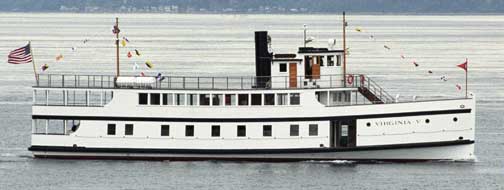 |
|---|
VIRGINIA V
 |
|
|---|---|
| The ship is 125 ft. (38m.) long and is powered by a 400 indicated horse power triple expansion steam engine built in 1898. Her draft is 8 ft. (2.4m.) with a displacement of 150 tons, 99 GT. 67 net tons. For pictures of her engine see “Smoke Ash & Steam, 2nd edition”. | |
The ship blows her whistle out side the harbour to alert the citizens of the town.
The ship enters Gig Harbor The people on the dock waiting for the ship to tie up.
|
With the advent of small vertical steam engines a small fast propeller-driven boat appeared on protected waters such as lakes and inlets. They were usually passenger freight boats that could enter smaller harbours. Their bigger cousins needed large docks for loading passengers and cargo. The small communities along the shores of lakes and inlets depended on them for supplies and transportation. They usually were fairly narrow for their length and if not loaded properly became unstable. In Puget Sound these small, fast wooden vessels were known as the “mosquito fleet."
After a major restoration, including a new boiler, she made a trip to one of her old ports of call. She arrived in Gig Harbor on May 29, 2002. At one time when these ships arrived it was a major event. As was the case when the steamer arrived in ports all over the continent everyone came down to meet it. These vessels brought far more than supplies and passengers. They brought news of the outside world.
Many residents of Gig Harbor boarded the ship after it docked. The interest in the arrival of the steam ship was as high as it had been a 100 years ago. |
Photographs and story by R. Sheret
All images and text is owned by Western Isles Photo/Graphics, R. Sheret or other named contributors.
Contact us - westisle@islandnet.com
Home - Shop - Books - History - Marine Photographs